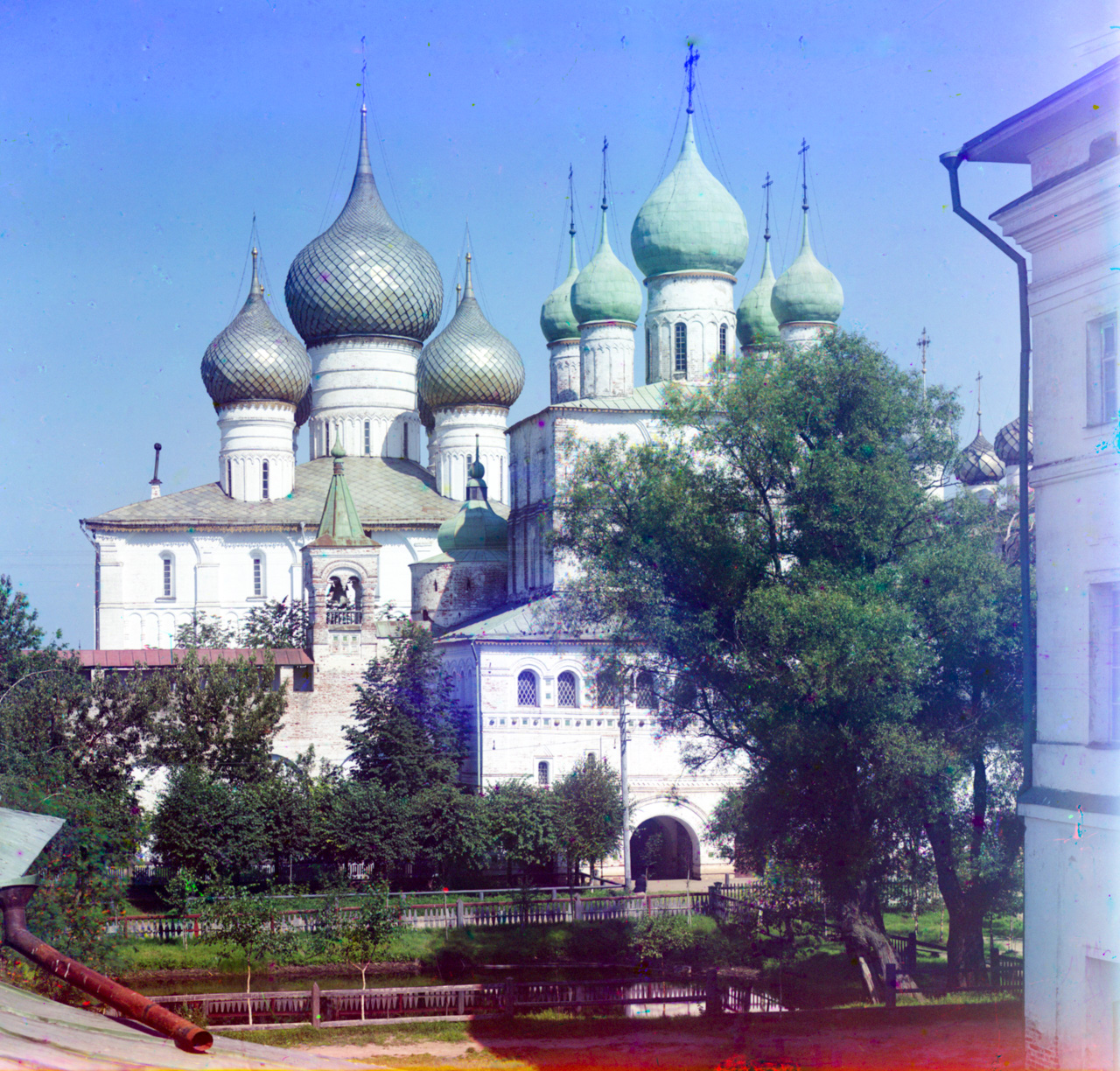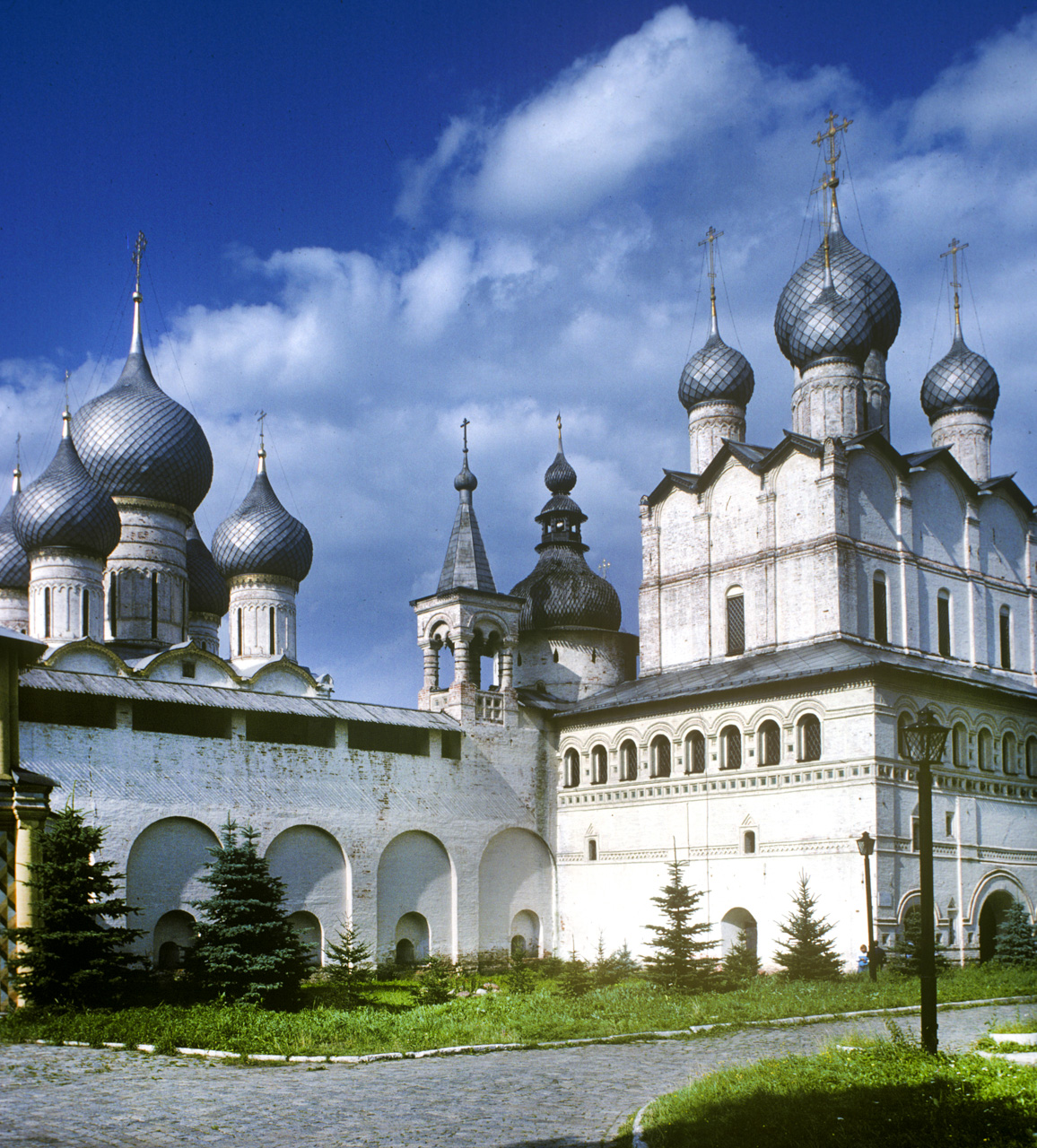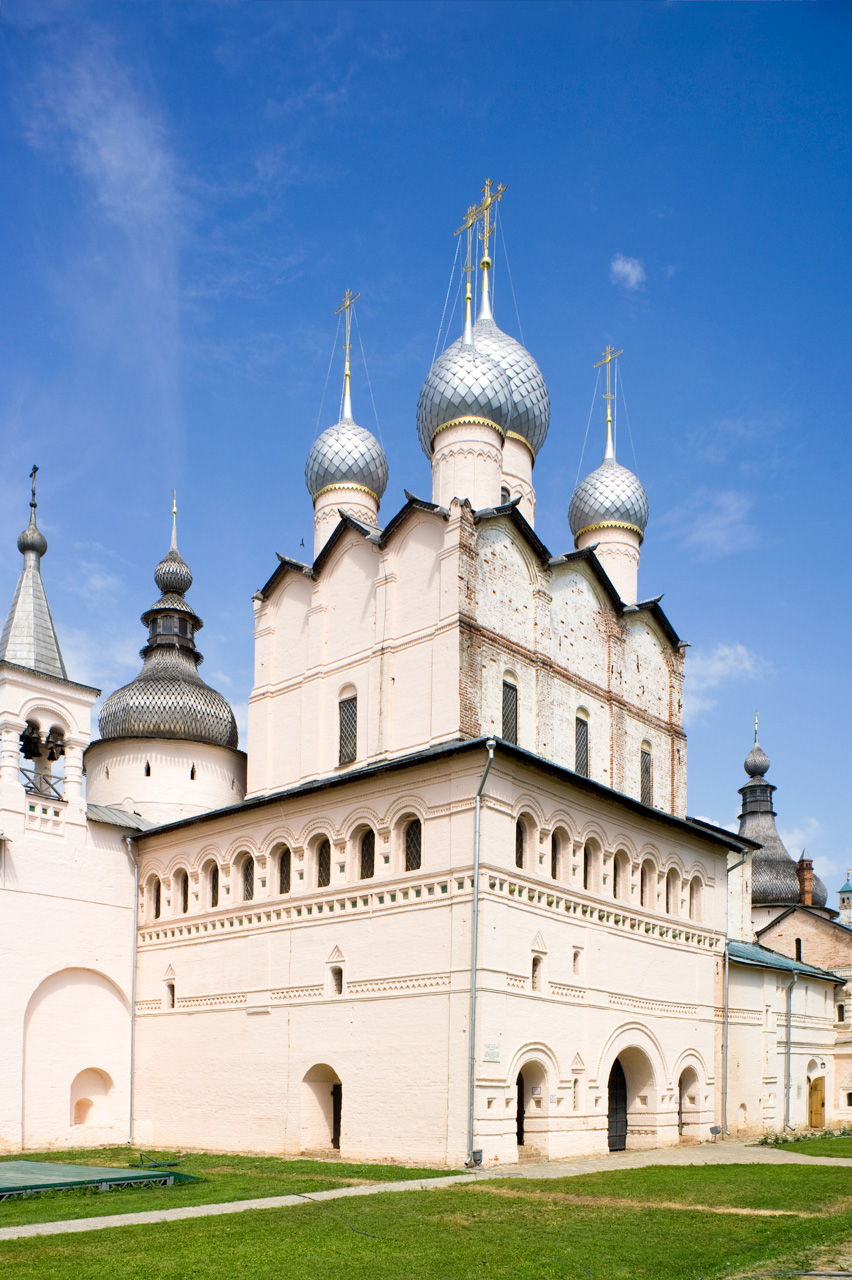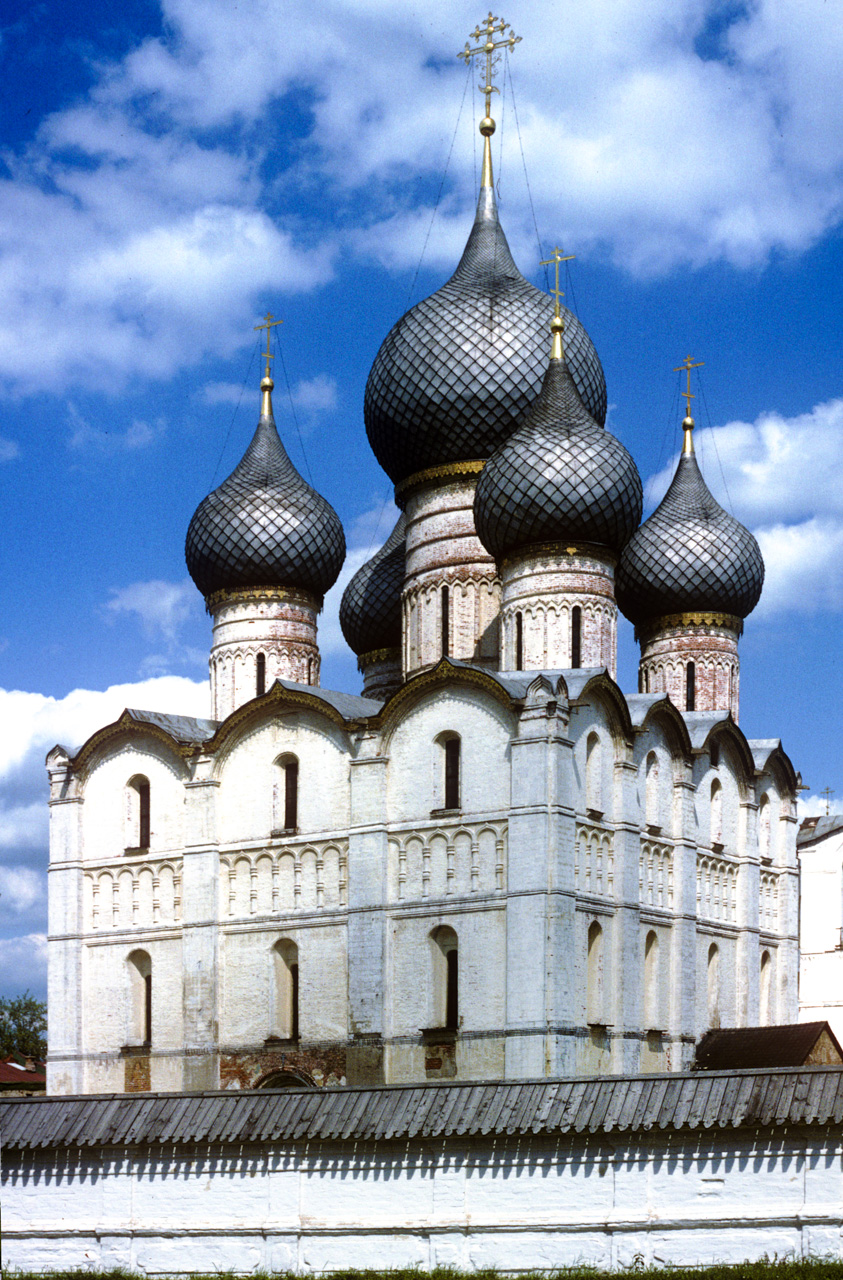The Kremlin of Rostov the Great: Last Masterpiece of medieval Russia
 Rostov kremlin. Church of Resurrection (right), north wall, Dormition Cathedral. Oct. 4, 1992. / Photo: William Brumfield
Rostov kremlin. Church of Resurrection (right), north wall, Dormition Cathedral. Oct. 4, 1992. / Photo: William Brumfield
At the beginning of the 20th century, the Russian chemist and photographer Sergei Prokudin-Gorsky invented a complex process for vivid, detailed color photography. Inspired to use this new method to record the diversity of the Russian Empire, he photographed numerous historic sites during the decade before the abdication of Tsar Nicholas II in 1917.
In 1911, Prokudin-Gorsky visited Rostov Veliky, or Rostov the Great, located some 130 miles northeast of Moscow. Rostov is one of the earliest historically attested towns in Russia. It was first mentioned under 862 in the ancient chronicle "Tale of Bygone Years." Prokudin-Gorsky traveled to Rostov not only to photograph its monumental architecture, but also its Museum of Antiquities, whose august patron was Nicholas II. My own photographs were taken during several visits from 1988 through 2013.
 Rostov kremlin. Church of Resurrection (right), north wall, Dormition Cathedral. View north from Metropolitan's chambers. Summer 1911. / Photo: Sergei Prokudin-Gorsky
Rostov kremlin. Church of Resurrection (right), north wall, Dormition Cathedral. View north from Metropolitan's chambers. Summer 1911. / Photo: Sergei Prokudin-Gorsky
Rostov's main architectural ensemble is its majestic kremlin, which rises above the north shore of Lake Nero. Although most of the ensemble was not built until the 17th century, this citadel conveys an unforgettable sense of Rostov's importance for medieval Russia.
A valuable patron
The ensemble’s original designation was the Court of the Metropolitan, in recognition of its founder, Metropolitan Jonah of Rostov. After Patriarch, Metropolitan is the highest ecclesiastical rank in the Russian Orthodox Church. An ambitious, dynamic church leader, Jonah Sysoevich (ca. 1607-90) was the son of a country priest named Sysoi. Tonsured at the Resurrection Monastery in Uglich, he rose through the regional monastic hierarchy and in 1652 was appointed Metropolitan of Rostov by the newly elected Patriarch Nikon in Moscow.
 Rostov kremlin. Church of Resurrection (right), north wall, Dormition Cathedral. Southwest view. August 21, 1988. / Photo: William Brumfield
Rostov kremlin. Church of Resurrection (right), north wall, Dormition Cathedral. Southwest view. August 21, 1988. / Photo: William Brumfield
Jonah had at his command land holdings and villages with some 16,000 peasants, as well as the best craftsmen and artists of a large, prosperous diocese. Within 20 years — between 1670 and 1690 — Jonah's builders erected not only several large churches and other buildings for the Metropolitan's Court and residence, but also magnificent walls with towers and gate churches.
Among Prokudin-Gorsky’s several photographs of the kremlin is a view north from the Metropolitan’s Chambers. On the right is the superb Church of the Resurrection, located over the north Holy Gate, which served as the main entrance to the kremlin from Cathedral Square.
 Rostov kremlin. Church of Resurrection. South view. Oct. 4, 1992. / Photo: William Brumfield
Rostov kremlin. Church of Resurrection. South view. Oct. 4, 1992. / Photo: William Brumfield
Architectural treasures
Built in 1670, the Resurrection Church was one of the earliest churches within the ensemble. Its extended base supports an enclosed gallery on the south and west. The main structure is crowned by five soaring cupolas topped with ornamental iron crosses. Its interior, also photographed by Prokudin-Gorsky, is covered with frescoes and will be the subject of a subsequent article. On the wall to the left of the church is a small bell pavilion.
The Rostov kremlin walls, supported by massive arches, resemble the late 17th-century walls of the St. Cyril-Belozersk Monastery in Kirillov, which was intended to serve as a mighty fortress guarding the Russian North. The Rostov kremlin, however, was never intended for military purposes, and its walls are solely for the imposing effect desired by Jonah.
 Rostov kremlin. Church of Resurrection. Southwest view. Aug. 21, 1988. / Photo: William Brumfield
Rostov kremlin. Church of Resurrection. Southwest view. Aug. 21, 1988. / Photo: William Brumfield
Visible beyond the walls on the left is the upper part of the Dormition Cathedral, first built of stone in the mid-12th century and rebuilt twice thereafter. Its final form, erected in 1508-1512, was modeled on the Dormition Cathedral in the Moscow kremlin, thus symbolizing the spiritual unity of the Muscovite realm.
As with many other major Russian churches, the Dormition Cathedral’s original curved roofline was later replaced with a simpler sloped roof visible in Prokudin-Gorsky’s photograph. My photographs show the post-war restoration to the earlier roofline that followed the contours of the semicircular gables (zakomary). My more recent views also show changes in the color of the Resurrection Church walls.
 Rostov kremlin. Church of Resurrection. Southwest view. July 12, 2012. / Photo: William Brumfield
Rostov kremlin. Church of Resurrection. Southwest view. July 12, 2012. / Photo: William Brumfield
Otherwise, a comparison of our photographs shows few changes over the decades. This stability is in no small measure due to the remarkable success of an early Russian preservation effort. With the transfer of the metropolitanate from Rostov to Yaroslavl in 1787 the Rostov kremlin rapidly fell into decay. Many of its buildings were used as warehouses, and there were thoughts of demolishing structures for their brick.
Fortunately, in the late 19th century Rostov merchants gathered funds to maintain the ensemble. In 1883 the White Chamber, built as a banquet hall for the Metropolitan of Rostov, opened as a museum of church antiquities, predecessor of the current distinguished Rostov Kremlin Museum. Thus through local pride Metropolitan Jonah’s visionary project was preserved for Prokudin-Gorsky and many subsequent generations.
 Cathedral of the Dormition. Southwest view. June 28, 1995. / Photo: William Brumfield
Cathedral of the Dormition. Southwest view. June 28, 1995. / Photo: William Brumfield
In the early 20th century the Russian photographer Sergei Prokudin-Gorsky invented a complex process for color photography. Between 1903 and 1916 he traveled through the Russian Empire and took over 2,000 photographs with the new process, which involved three exposures on a glass plate. In August 1918 he left Russia with a large part of his collection of glass negatives and ultimately resettled in France. After his death in Paris in 1944, his heirs sold his collection to the Library of Congress. In the early 21st century the Library digitized the Prokudin-Gorsky Collection and made it freely available to the global public. A number of Russian websites now have versions of the collection. In 1986 the architectural historian and photographer William Brumfield organized the first exhibit of Prokudin-Gorsky photographs at the Library of Congress. Over a period of work in Russia beginning in 1970, Brumfield has photographed most of the sites visited by Prokudin-Gorsky. This series of articles will juxtapose Prokudin-Gorsky’s views of architectural monuments with photographs taken by Brumfield decades later.
Read more: The Massive Walls of Solovki: From Prokudin-Gorsky to the present
If using any of Russia Beyond's content, partly or in full, always provide an active hyperlink to the original material.
Subscribe
to our newsletter!
Get the week's best stories straight to your inbox